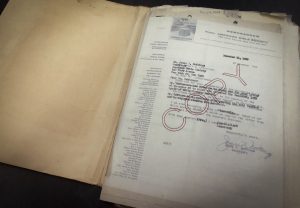Communicating Before E-Mail and Zip Codes
by admin | May 31, 2019 8:39 am
As I mentioned last week, I am spending much of the summer going through the R.G. LeTourneau archives, placing the material in acid-free folders and categorizing it. I enjoy this type of work. I fully realize that, despite three of us working 29 hours a week on the project, we will barely make a dent in the mountain of material. But it moves the project a bit farther down the road, and it provides a glimpse in the famed Christian industrialist’s many activities – and the voluminous correspondence he received from around the world.
The material I am going through now is from 1959. Mr. R.G. was 71 but still working full-time, traveling the country, visiting large mission projects created by the LeTourneau Foundation in Peru and Liberia. I recently finished going through a fat folder of correspondence answered by his secretary. Just four months’ worth filled five file folders and reminded me how different the technology was 60 years ago. For example:
- There were no zip codes (Zone Improvement Plan) in 1959, though larger cities had a number between the city and the state, such as “Pittsburgh 5, Pennsylvania” to subdivide the city’s mail. Zip codes would not be put into effect until 1963 and were made mandatory for bulk mailers four years later. Mail sent to Mr. R.G. often contained only his name and “Longview, Texas.” Simpler times.
 [1]
[1] - Area codes in 1959 were gaining limited use, but most telephone calls could be made with five digits. For example, I still remember the phone number of our house at 27 Valley St., Allenstown, N.H. It was HU. 5-3908. (The “HU” was short for Hunter). If someone from outside town called, seven digits were required, but otherwise not.
- Since everything was either written or typed, carbons were made of typed copies, on thin tissue paper. The original correspondence to the company was stapled to the carbon. People wrote in hopes of getting Mr. R.G. to invest in their inventions; to help them open a uranium mine on inherited property; to build a canal across the northern end of South America; to adapt LeTourneau’s famed huge electric tires for farm tractors (didn’t happen); to support a mission in Venezuela; or just to say how much they enjoyed receiving Now, the company newsletter that at the time was sent free to more than 600,000 homes and businesses. One of my favorite letters was from a 9-year-old boy in Dallas, who sent a drawing of an underground stadium, which he decided could be built using LeTourneau Industries’ giant earth-moving equipment.
- Telegrams were in common use as the 1950s drew to a close. Often a Western Union telegram would arrive to simply warn the recipient that a more detailed letter was forthcoming. Likely, it was cheaper than calling long distance, which was billed at a premium. Many letters arrived with a blue-and-red logo that proclaimed it had been sent via Air Mail, which cost 8 cents a stamp — twice as much as a regular stamp. Presumably, those letters arrived a bit quicker than conventional delivery.
- Photostatic copies were coming into existence, but the quality was poor. The copies in the archive have turned brown and sometimes are illegible.
I have become quite adept at removing staples from fragile, six-decade-old paper. It takes a bit of patience to not tear the paper unduly, but the staples and paper clips must be removed to ensure the documents are not further contaminated. Every hour or so I dose myself with hand sanitizer.
I began to reflect on how much life has changed in those 60 years. I was 4-years-old in 1959 and grew up with many of the items used then to communicate – rotary telephones, manual typewriters, communicating by letter and waiting impatiently for a reply from my Swedish pen pal.
Someone writing a letter to Mr. R.G. in 1959 from, say, Ontario, Canada, might have to wait two weeks for a reply. Often it meant their dreams were dashed, because there simply was no way this hugely generous man could answer every request. But he did answer every letter, or at least his secretary did, always graciously though briefly. That alone speaks to his character, as do these piles of letters and replies I slowly wade through.
- [Image]: http://garyborders.com/pages/communicating-before-e-mail-and-zip-codes/rg-letters/
Source URL: https://garyborders.com/pages/communicating-before-e-mail-and-zip-codes/